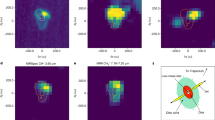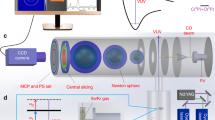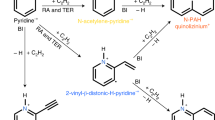Abstract
The far UV photochemistry of CH4 and of NH3 has been widely studied1,2 and the primary processes are relatively well known. In contrast no experimental study of far UV photochemistry of CH4–NH3 mixtures had been published before our preliminary report3. We report here new photochemical data on the effect of the mole fraction of NH3 on the production of N-containing organics. Photolysis of CH4–NH3 mixtures at 147 nm leads to the formation of nitriles when the mole fraction of NH3 is low and to the formation of amines when the mole fraction of NH3 is high. Study of mixtures in which the NH3 mole fraction is very low has been particularly emphasized. The main conclusions are that (1) important quantities of nitriles may have been photo-produced on the primitive Earth if a low partial pressure of NH3 remained and (2) nitriles are the main N-containing organics that may be photoproduced in the atmosphere of the giant planets.
This is a preview of subscription content, access via your institution
Access options
Subscribe to this journal
Receive 51 print issues and online access
$199.00 per year
only $3.90 per issue
Buy this article
- Purchase on Springer Link
- Instant access to full article PDF
Prices may be subject to local taxes which are calculated during checkout
Similar content being viewed by others
References
Calvert, J. G. & Pitts, J. N. Jr in Photochemistry, 203–204, 498 (Wiley, New York, 1966).
Okabe, H. in Photochemistry of Small Molecules, 269–272, 298–299 (Wiley, New York, 1978).
Toupance, G., Bossard, A. & Raulin, F. Origins of Life 8, 259–266 (1977).
Raulin, F., Bossard, A., Toupance, G. & Ponnamperuma, C. Icarus 38, 358–366 (1979).
Bark, L. S. & Higson, H. G. Talanta 11, 471–479; 621–631 (1964).
Stein, S., Bohlen, P., Stone, J., Dairman, W. & Udenfriend, S. Archs. Biochem. Biophys. 155, 202–212 (1973).
Hellner, L., Masanet, J. & Vermeil, C. J. chem. Phys. 55, 1022–1028 (1971).
Masanet, J., Fournier, J. & Vermeil, C. Can. J. Chem. 51, 2946–2951 (1973).
Watanabe, K., Zelikoff, M. & Inn, E. C. Y. Geophys. Res. Pap. No. 21 (1953).
Ferris, J. P. & Chen, C. T. Nature 258, 587–588 (1975); Ferris, J. P., Nakagawa, C. & Chen, C. T. Commun. 29th COSPAR Meet. Philadelphia (1976).
McNesby, J. R. J. atmos. Sci. 26, 594–599 (1969).
Kuhn, W. R. & Atreya, S. K. Geophys. Res. Lett. 4, 203–206 (1977).
Atreya, S. K. & Donahue, T. M. Rev. Geophys. Space Sci. 17, 388–396 (1979).
Mizutani, H., Mikuni, H., Takahasi, M. & Noda, H. Origins of Life 6, 513–526 (1975).
Author information
Authors and Affiliations
Rights and permissions
About this article
Cite this article
Bossard, A., Toupance, G. Far UV photolysis of CH4–NH3 mixtures and planetary studies. Nature 288, 243–246 (1980). https://doi.org/10.1038/288243a0
Received:
Accepted:
Issue Date:
DOI: https://doi.org/10.1038/288243a0
This article is cited by
-
Chemical evolution: The first stages
Naturwissenschaften (1983)
-
Organic synthesis from reducing models of the atmosphere of the primitive earth with UV light and electric discharges
Journal of Molecular Evolution (1982)
-
Photochemistry of NH3, CH4 and PH3. Possible applications to the Jovian planets
Origins of Life (1982)
-
Organic syntheses from CH4?N2 atmospheres: Implications for Titan
Origins of Life (1982)
Comments
By submitting a comment you agree to abide by our Terms and Community Guidelines. If you find something abusive or that does not comply with our terms or guidelines please flag it as inappropriate.



